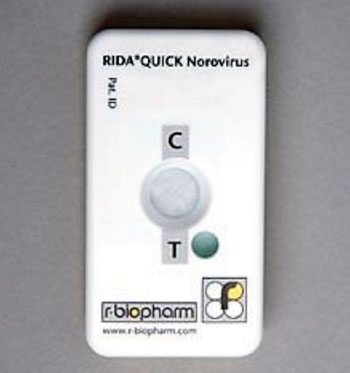Rapid Immunochromatographic Tests Evaluated for Novel Norovirus
By LabMedica International staff writers
Posted on 08 Feb 2016
A worldwide spread is conceivable as a novel Norovirus emerged in Asia in the winter of 2014/15 and Norovirus diagnostic assays need to be evaluated to investigate if they adequately detect this emerging genotype.Posted on 08 Feb 2016
Seven commercially available Norovirus immunochromatographic (IC) tests are available in Europe and all have the capacity to detect strains of genogroup GII.17 in stool, but sensitivities vary and partly depend on the viral load in the samples.

Image: The RidaQuick Rapid Immunochromatographic Test for Norovirus (Photo courtesy of R-Biopharm AG).
Virologists at the University Hospital of Dijon (Dijon, France) used 10 samples that had been collected from patients affected by five different gastroenteritis outbreaks. One outbreak was related to oyster consumption, while the four others were caused by person-to-person transmission. Three of the four latter outbreaks had occurred in nursing homes and the fourth in a hospital. All 10 samples had been previously shown to be GII.17 Norovirus-positive by sequencing of the ribonucleic acid (RNA)-dependent RNA polymerase (RdRp) region and the N-terminal/shell (N/S) region.
All seven commercial IC tests were performed according to the manufacturers’ instructions. Due to limited amounts of samples, one assay per test was done, except when the results were negative, in which case they were controlled by a second assay when possible. The virus copy numbers were quantified by real-time reverse transcription-polymerase chain reaction (RT-PCR) on the same day. Measurements of the virus titers in each sample allowed to demonstrate that a positive result could be obtained with most of the IC tests (five in seven) if the samples presented a minimal load of 4.88 × 108 virus copies/g of stool. The lowest viral load detected by an IC test was 6.54 × 106 copies/g of stool and this gave a weak positive signal with the RidaQuick Norovirus test (R-Biopharm AG, Darmstadt, Germany). Three samples in the study, all of which had relatively high viral loads of greater than 1.34 × 109 copies/g of stool nevertheless gave negative results with some of the tests.
The authors concluded that the seven IC tests evaluated were able to detect GII.17 with various sensitivities due to virus titers, and possibly antigenic differences and kit design. Therefore some IC tests may need to be optimized for the detection of Norovirus genogroup GII.17. The study was published on January 28, 2016, in the journal Eurosurveillance.
Related Links:
University Hospital of Dijon
R-Biopharm AG














